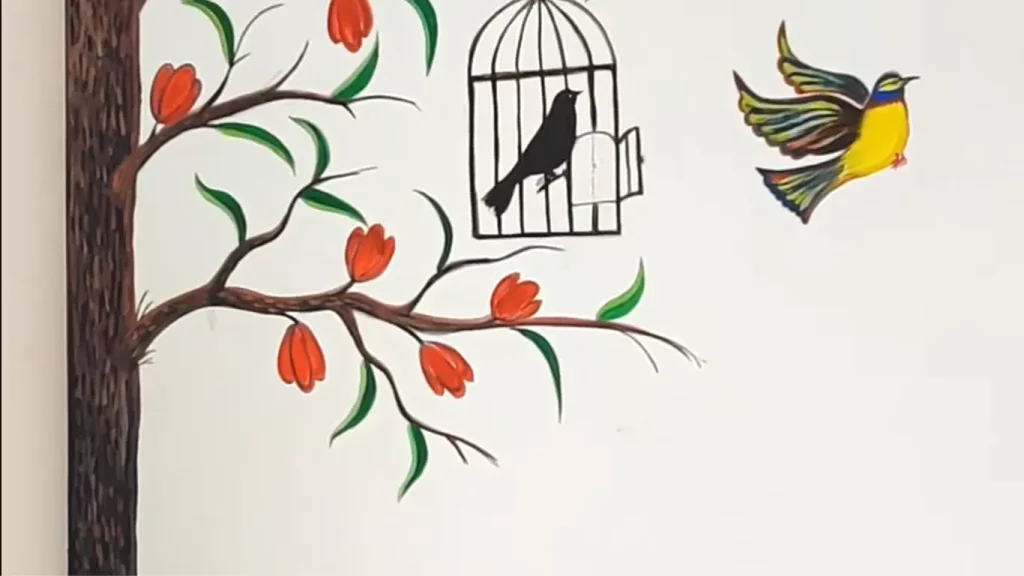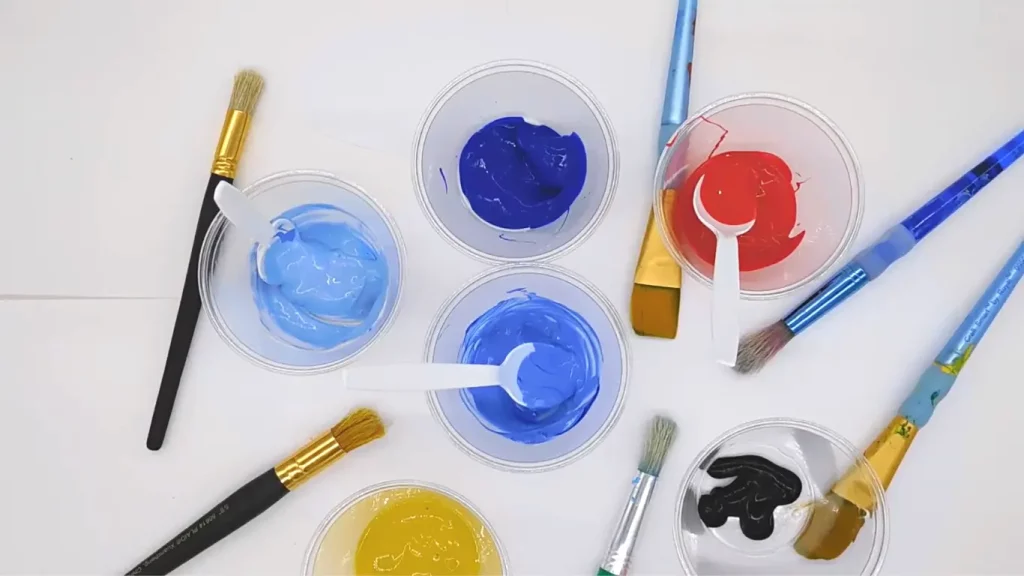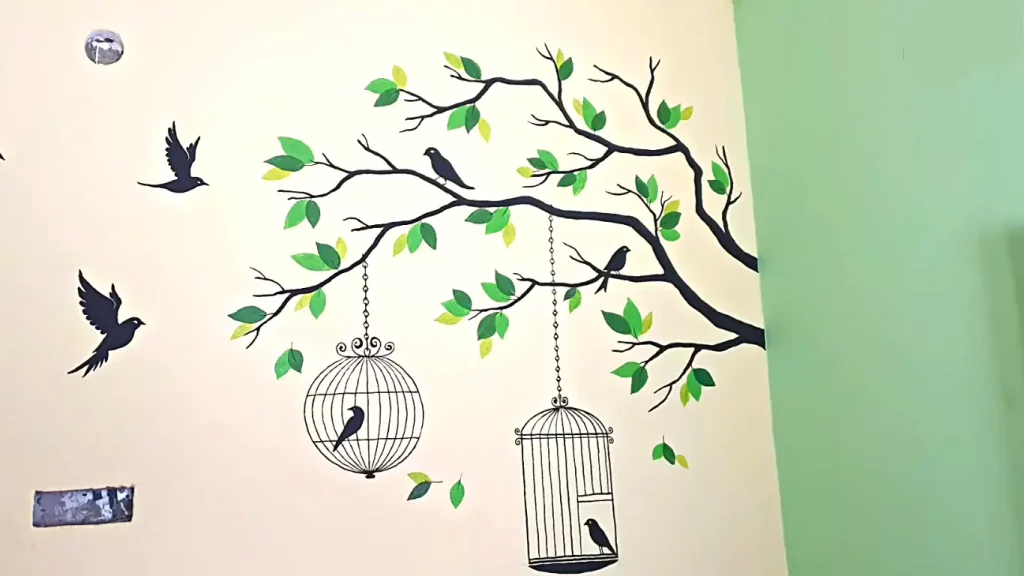Tempera paint, which is also very popularly known as poster paint, is a water-based paint that has few chemical bindings mixed with it. It is a non-allergen cum non-toxic painting solution.
Since this is not permanent paint, many painters are skeptical about using this paint for their paintings. As a wall painter, you may wonder whether you can paint on walls or not using Tempera Paints.
The short answer is yes; you can use Tempera Paint to make beautiful and colorful pictures on your boring walls.

Nowadays, Tempera Paints are mostly seen being used on papers, ceramics, wood, rocks, windows, and even on your hair as well, but they can be used to paint your room walls with your creative ideas and designs. In this guide, I will tell you everything about painting with Tempera paint on walls.
Tips for Getting the Best Results of Tempera Paint on Walls
In the 1600s century, Tempera paint arrived in human society. Egg tempera was the first medium that became popular as Tempera. Basically, those were colors made with natural pigments and egg as a blinder. With the flow of time, the characteristics and the recipe of making Tempera have fully changed.
Now, Tempera paint is preferable due to its flexibility and color-mixing quality. A plane or flat surface is the best place to paint with Tempera paint. Tempera can also work on walls.
The ancient egg tempera was vastly used to draw wall paintings though today’s tempera paints are not used that much for that purpose.
But still, Tempera can be used to make gorgeous wall paintings; we can find many wall and wood paintings with Tempera. To use Tempera on a wall, you should consider some steps to get a better result. The steps are as follows:
Follow the Instructions Given By the Manufacturers
All of us are well aware that every single color bottles come with a label on the body, and there are a few instructions written by the vendor. It is advisable to read, understand and follow the instructions.
Obviously, the instructions on a product’s label are very useful as those instructions have been tested and justified by the manufacturers and the producers for a long time. So following them will be your primary tip!
Find A Wall That Is Crack-free
Tempera Paint has to be used on smooth and even surfaces as it flakes and cracks easily, and hopefully, you don’t want to lose your painting or make it damaged.
So, before making a wall painted with Tempera, select a crack-free wall for getting long-lasting and eye-catchy artwork.
Putting Sealant Coating
Sealant is a liquid solution applied to walls before painting so that it can be more sticky to the paint and also absorb the original shed of the paint.
A sealant solute can fill the small cracks in the wall and makes it smooth and flat to make it suitable for tempera painting.
The Wall Must Be Dry
Tempera paint is very similar to watercolor. That’s why this is also re-solvable with water. If you want to work comfortably with Tempera paint, then make sure that the surface you are going to work on is totally dry. The best result of your painting will be visualized only when you will paint on drywall.
How To Use Tempera Paint On Wall
Prepare the Wall: Preparing the surface before painting is very important. You can use a damp cloth to remove any dirt or debris from the surface. If there is any dirt or debris left on the surface, it will create trouble for the paint’s adhesion to the surface, and also you will get an uneven finish. After cleaning, allow the wall to dry completely.
Use a Primer: Using a water-based primer would be of help. You can use Tempera paint on the wall without using primer. But a primer will increase the paint’s adhesion and will also improve its overall appearance.
Mix The paint Nicely: You have to mix the paint nicely. Add water to give the paint a creamy consistency. Don’t make the paint too thin; it will make the paint runny. If you find your paint too thick, consider adding a small amount of water to it.

Apply The Paint: Once your paint and surface are prepared, it’s time to apply the paint. Take a small brush or sponge brush to apply the paint. Use long even strokes to ensure an even appearance. If you want to apply a second coat of paint, allow the first coat to dry completely.
Add Design: Now that you applied the paint, you can add any details or designs if you want. You need to use a small brush or a stencil to create a beautiful design on the wall. Remember, If you want to use Tempera paint as latex paint or emulsion paint and paint the whole want with tempera paint, discard that thinking. Tempera paint is not wall paint; you can create artwork on the wall, nothing else.
Though tempera paint is not non-toxic and you can wash it easily, it is better to use a protective mask and gloves when working with paint.
Advantages And Disadvantages of Using Tempera Paints on Walls
Positive and negative are two mandatory parts of everything. Tempera paint also has those; now we will talk about the advantages and disadvantages of using Tempera Paint on walls.
Advantages
The advantages of using Tempera Paint on the wall are given below:
Nature-Friendly
Tempera paint is a non-toxic and non-allergic solute, so it is less harmful to nature. On the other hand, most acrylic paints include toxic chemicals that can make serious harm to the human body.
Creative Color Varieties
If you mix the blue color with the yellow color the result will be green. Tempera paint is used to teach school-going children about such color-mixing functionalities.
This type of paint is much easier than other paints for bringing color varieties by mixing with one another. Tempera paint is a fast-drying paint, so it is preferable to get a quick result.
Non-toxic
Tempera paint is now made with pigments and some non-harmful chemicals as blinders. As a result, Tempera paint is not-toxic or poisonous to the human body.
Sad but the truth is many of the popular paints in the market can even cause death to humans if they get into the mouth or nose somehow! From that perspective, Tempera Paint is very safe to use.
Easy to Use
Tempera Paint, known as Poster Paint, is a very comfortable color solute. This is one of the most recommended paints for school children to learn painting because it can be removed or washed off easily.
Just a simple wash with water and soap can fully clear up the paint. If you are a painting freak and want to paint on bedroom walls on your own, then you can use Tempera paint. There is no way to hesitate if you make any mistakes; you can easily clean that and make new ones.
Disadvantages
Not So Gorgeous as Acrylic
Acrylic paints are mostly chemical solutes. As a result, they give a very shiny look all the time. But in the case of Tempera paint, it is a little less shiny, and since it gets absorbed by the surface, the glow of Tempera paint reduces a bit over time.

Tempera Paint is Not Permanent
Tempera paint is preferred by people because of its quick drying and easily removing characteristics. But the easily removing character is a big disadvantage of using it on walls.
Wall paints are done to keep the walls permanently gorgeous, so we don’t want that any sudden drop of water or just a touch of a sweated hand to take away our beautiful wall painting.
To ensure the permanence of Tempera Paint on the wall you have to go through a couple of hassles.
Extra Costing to Make Permanent
Since most of the paints available in the market are permanent, they do not need extra steps to be made permanent. Tempera paint is not a permanent solute by nature.
To make it permanent, you need to go through an extra process that will cost you both time and money.
Conclusion
Tempera Paint is a very common painting method that is preferred for making paintings on paper, paper boards, hard boards, wood, glasses, and walls. This is a very appreciated painting medium.
To beautify your boring wall and make them charming with colors, different shapes, and art, you should follow the steps we talked about. Tempera Paint is definitely going to make your walls look superb.

S. Pushon is a paint expert, self-taught artist, and currently working as an adviser in the paint industry as a Quality Improvement and Development Assistant.
An artist by heart, he draws remarkable art pieces and as a professional paint industry individual, he seeks the insight and shares with enthusiasts. Read more…
